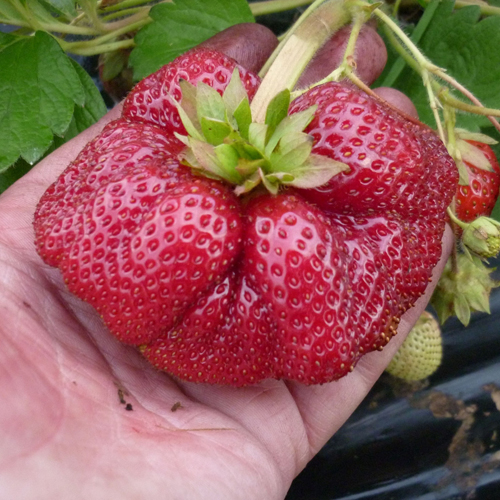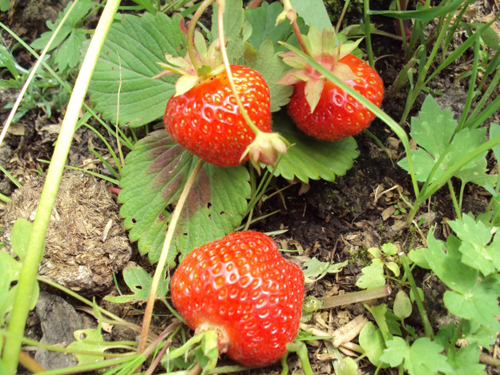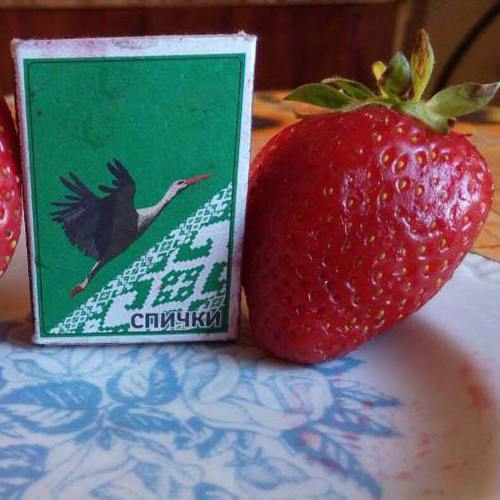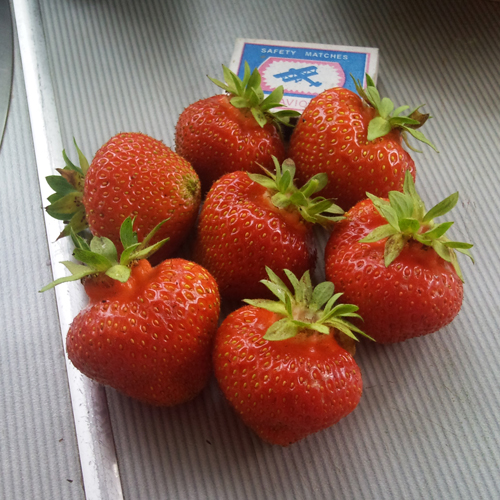Strawberry variety Eliane (Eliani)
Eliane is a mid-early variety of garden strawberries (strawberries) of short daylight hours. Bred by the specialists of the Dutch company Vissers Aardbeiplanten B. V. in 1998, the authors are Albert Konnings and Gebr. Vissers. The variety is recommended for growing in private households and small farms in small volumes. It is famous for its beautiful homogeneous berries, excellent taste, good yield. Strawberries are very whimsical to growing conditions, not in all regions can reveal their potential, zoned for a mild climate without excessively high or low temperatures. With proper care, it can be grown quite successfully in central Russia and some regions of Ukraine.

The plant is powerful, tall. Usoobrazovanie at an average level. The leaves are large, light green in color with a glossy shine, according to the observations of gardeners, they can "roll up" like a boat. Peduncles are very powerful, thick, erect, located at the level of leaves or higher, hold immature berries well, then, under the weight of a ripe crop, are laid on the ground.
Eliane berries are uniform, have a regular slightly elongated conical shape with a short neck, the sepal is slightly raised. The skin is dense, bright red, shiny, when fully ripe, it can acquire a darker shade, but not burgundy. Achenes are yellow, superficial, due to which the berries are better transported without losing their presentation. Strawberry pulp is light red, moderately dense, but not hard, very tender, very juicy, has a wonderful multifaceted aroma, playing with various strawberry, fruit and floral notes. Eliane berries, as they ripen, are colored gradually, starting from the sepal; in unripe, the tip is not colored. The fruits are easily detached from the stalk, while the sepal does not separate.

The taste of the variety is wonderful, very bright and multifaceted, mostly sweet, but with a graceful hint of acidity, which only adds to the splendor of the palate. Gardeners highly appreciated the taste of this strawberry in comparison with other varieties on the site, especially commercial ones, our heroine is often included in the list of favorites. Eliane berries are versatile in use, ideal for fresh consumption, perfect for processing, as well as freezing. Sufficiently dense pulp, strong skin and the ability to be stored for a long time in a chilled form allow you to safely transport berries over long distances. By the way, our heroine does not belong to the hard-fruited varieties, so her fruits are much softer in consistency than many popular commercial varieties.
Strawberries are distinguished by extended stable fruiting, the protrusion of the peduncles occurs alternately, as the berries ripen. The fruits do not become smaller from harvest to harvest, only by the end of the season they become a little smaller. The average weight of berries for the entire fruiting period is about 20 grams, at the first harvest the weight is slightly more - about 30 grams. Larger specimens are not uncommon, and sometimes giants weighing more than 50 grams are formed. There is also a very high percentage of first class berries. It is worth saying that the size of the fruits and their quality are highly dependent on agricultural technology. So, some gardeners complain about a lot of little things on the bushes, while others boast of very large berries. Of course, this parameter can be influenced by other factors, including the climatic conditions of the region, which is important.

As for the yield of Eliane, the numbers can vary greatly. According to some reports, the potential of the variety is really high - up to 2 kg of berries per bush.But are such results actually achievable, especially in the difficult climatic conditions of Russia? As a matter of fact, it is hardly worth counting on the result of more than 1 kg of fruits per plant, but in closed ground and with intensive agricultural technology, the figure, of course, will be higher. In general, according to numerous reviews of gardeners, strawberries manifest themselves in completely different ways in different regions, so it is extremely difficult to give accurate yield indicators. But to put it briefly - Eliane is able to provide you with a really good harvest, and you certainly will not suffer a complete fiasco when choosing this variety.
Strawberries ripen mid-early, roughly on par with the reference Elsantha, in the second or third decade of May. In different climatic conditions and depending on agricultural technology, it can begin to bear fruit both earlier and later. As already mentioned, the fruiting of our heroine is extended (about a month or a little more), but this is not always a plus. The fact is that by the very last harvest, the number and size of berries is already much smaller, therefore, commercially, long-term fruiting does not justify itself. And the gardener, of course, will be pleased to receive delicious beautiful berries for such a long time. By the way, in some regions, strawberries exhibit remontant properties, giving a second harvest in the fall, but, of course, it cannot be compared with the main one.

Eliane is quite resistant to fungal diseases and rot, it is not affected more often than other standard varieties. Still, it is worth noting that the variety is commercial, so regular high-quality preventive treatments are highly recommended. The winter hardiness of plants is relatively good, they can safely tolerate a temperature drop to -15 ° C during snowless periods. However, severe frosts with a small amount of snow will be fatal for strawberries. In the northern regions, special attention should be paid to plant protection both in winter and in spring, because Eliane is still not adapted to extreme conditions. In short, provide good cover for your plantings.
Drought resistance and heat resistance of the variety are at a very low level. Firstly, in such conditions, the taste of berries deteriorates, their size decreases, and the yield itself is significantly reduced. Secondly, the heat for a sissy Dutch woman can really become fatal - gardeners from the southern regions note frequent attacks during hot seasons. Thirdly, the berries are baked in the sun, however, not all over the place. Thus, it is imperative to ensure that your plants receive regular, abundant watering, as well as consider shading and mulching. In general, according to gardeners, Eliane is really very sensitive to environmental influences and is suitable for growing only in regions with a mild, stable climate, and in more extreme areas it is better to think about choosing a different variety.
Of the nuances of agricultural technology, which we have not yet mentioned above, only a couple of points should be highlighted. First, strawberries react negatively to excessive thickening. It is better to plant bushes at a distance of at least 30-35 cm, if possible, you can plant it more freely. The second caveat is that the variety needs regular, abundant feeding. Since it is commercial, a simple rule applies - the better the nutrition, the greater and better the yield. Regarding the longevity of strawberries, opinions differ. In general, with intensive use, Eliane can give bountiful harvests for two years, maximum 3, then the yield will decline. Some sources report that plants can bear fruit perfectly for 10 years, but this is somehow hard to believe. Still, the variety is commercial, which automatically implies a short period of its use - plants quickly develop their resource, especially with intensive agricultural technology.
Let us briefly summarize all of the above.The variety is really very good and for good reason received a lot of positive reviews. But it has a huge minus - it is too gentle for our harsh climatic conditions. In an “extreme” environment, unusual for Eliana, plants are unable to reach their full potential. On the other hand, cultivation in greenhouses in a controlled environment can solve the problem. Under optimal growing conditions, strawberries can indeed produce impressive results. But, according to gardeners and farmers, not so impressive as to become a definite favorite. In a word, it is worth trying to grow this variety, but you do not need to immediately pin great hopes on it, since the disclosure of its full potential depends on many factors, including your concern.








